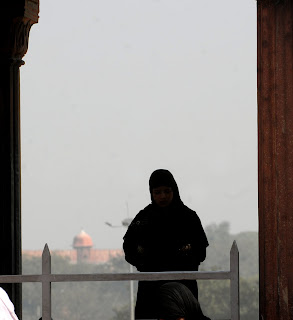
It was quite late night. I think it must be around 3 am. If you go by old Delhi's orthodox mindset, women are not allowed to venture out that late. But I was a trifle puzzled to see young and the old, clad in dark but expensive burqas returning in a group after attending a marriage reception.
Most weddings in Delhi take place in the weekends. These are considered to be the expensive weddings of Delhi. People in Quraish Nagar are wealthy businessmen and they don't mind spending a little more to flaunt their wealth.
Quraish Nagar residents are not so liberal in the strict sense. When I saw these women, I was amazed. Young, petite beauties with only their eyes visible from the hizab walking. You could see the glint in their eyes. They giggled and laughed as they walked down the empty lane. Freedom at midnight? I'm not sure. But from their soft demeanour and lighthearted talks it became clear that they really enjoyed their night out without male companions.
During my three-year stay at old Delhi, I've seen these women step out late in the night and mostly in the weekends to attend marriage functions. I was unable to fathom about this odd timing. I used to fall back on Zaki, the caretaker of the house. "It is like this only. Marriages take place quite late in old Delhi. So most of the jenanas would reach late at the functions, gossip and then have their food," he quipped.
Zaki, 35, has been staying in this house at Idgah Road since 1986. So he may know a lot more about Quraish Nagar residents than me. Short, clad in a lungi, Zaki would always opened the door for me at late night. But he used to give me a frown look. I'm sure he used to hate me for waking him up at that late. He would murmur. But surprisingly, soon he became used to my erratic journalistic schedule.
Zaki came from Dharbhanga district in Bihar as a cheap labourer in the mid-eighties. But he soon ended up looking after this small room at Idgah Road after his employer found him to be honest and dedicated at his work. His change of duty meant that he was destined to enjoy all the luxuries in life: less work, more rest. No wonder then without his owners' absence (who mostly stayed in Lucknow), it became a sort of luxury for Zaki whose favourite past time was to lit a Howrah bidi and then switch on the 14" b/w TV.



